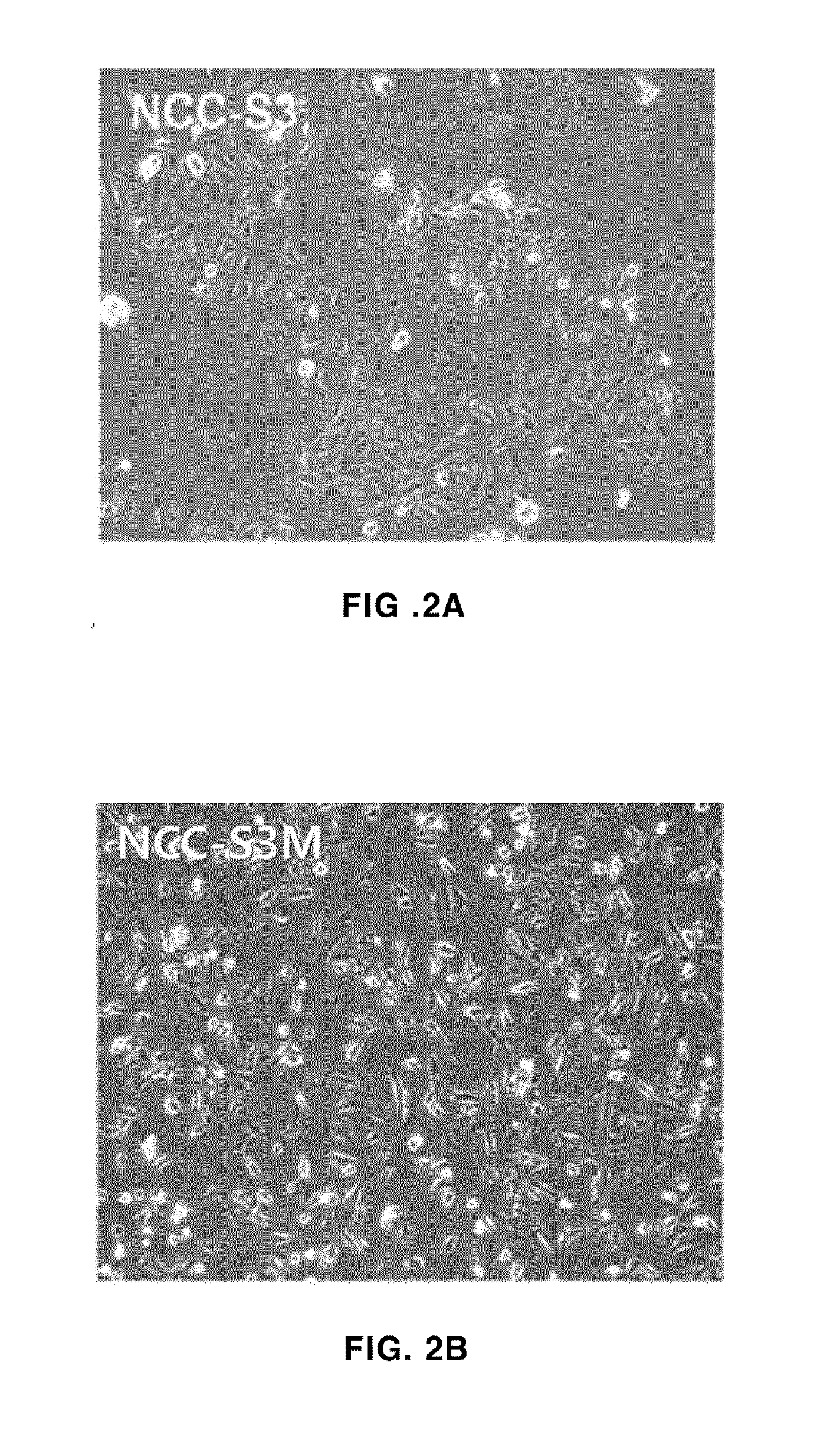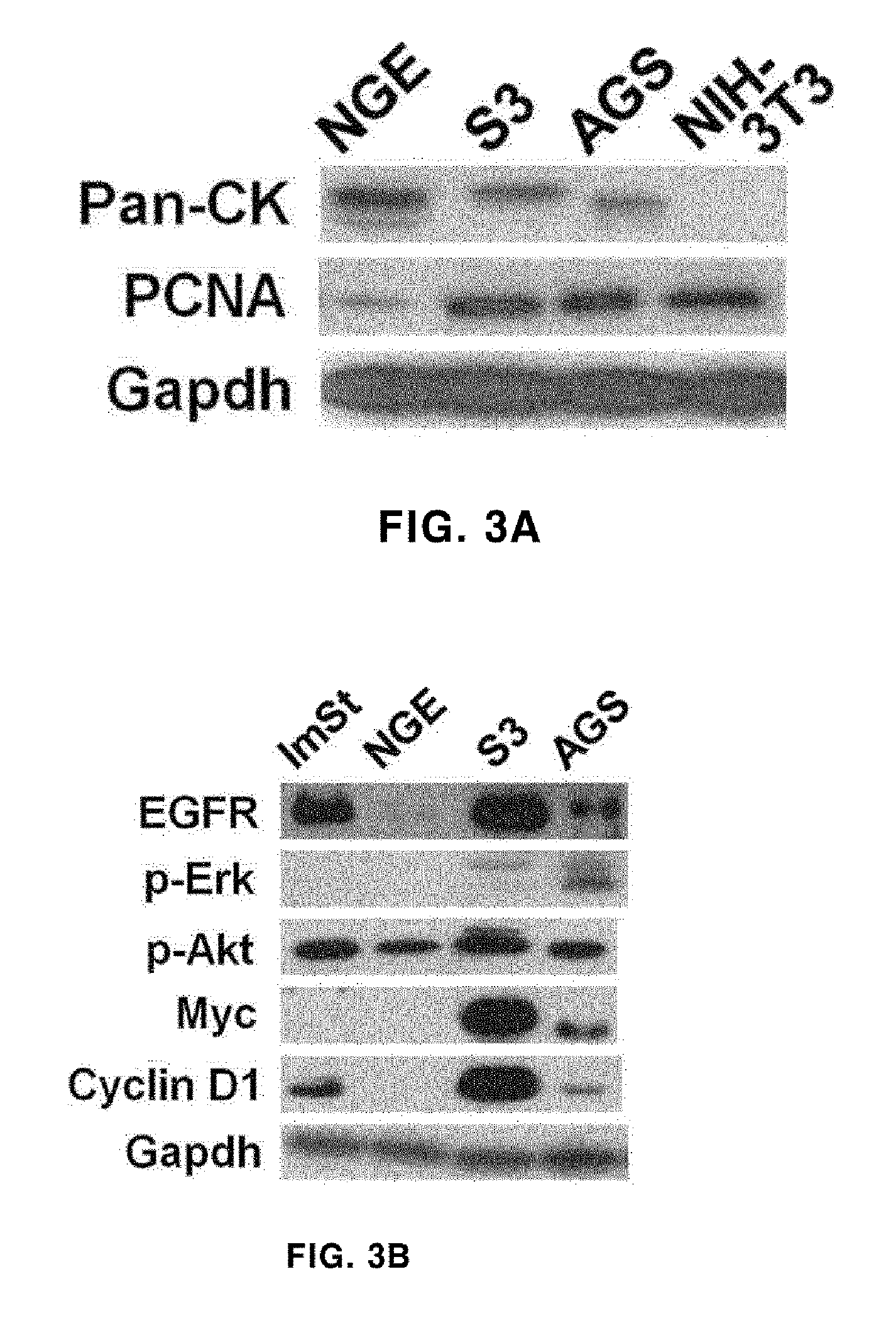Gastric cancer cell line derived from murine gastric adenocarcinoma lacking p53 and e-cadherin and use thereof
a gastric cancer and cell line technology, applied in tumor/cancer cells, instruments, biochemistry apparatus and processes, etc., can solve the problems of difficult to predict the response rate to solid tumors, and achieve the effects of high metastatic property, effective evaluation, and promotion of cancer growth
- Summary
- Abstract
- Description
- Claims
- Application Information
AI Technical Summary
Benefits of technology
Problems solved by technology
Method used
Image
Examples
example 1
Construction of a Mouse of Naturally-Occurring Gastric Cancer
[0067]1-1 : Construction of a Mouse of Naturally-Occurring Gastric Cancer
[0068]In the present invention, orthotopic allograft models in a mouse with immunological competence were established for the isolation of a murine-derived gastric cancer cell line, and gastric cancer cell lines were isolated from naturally formed gastric adenocarcinoma by constructing Pdx1-cre, Trp53F / F, and Cdh1F / F mice.
[0069]The Pdx1-cre, Trp53F / F, and Cdh1F / F mice were prepared using the method disclosed previously (Park J W, et al., Mol Cancer Res., 2014), and heterotopic allografts were prepared in mice with immunological competence using the Pdx1-cre-negative, Trp53F / F, and Cdh1F / F mice. The severe combined immunodeficiency (SCID) mice were used after purchasing them from Orient Bio Inc. (Korea), and all the animal management and surgery procedures were approved by the Committee of Animal Management and Use of the National Cancer Center (Korea)...
example 2
Establishment of Primary Culture and Gastric Cancer Cell Line in the Murine-Derived Cancer Tissues
[0079]In the present invention, the primary culturing was performed using the tumor tissues isolated in Example 1 for the establishment of a gastric cancer cell line.
[0080]Specifically, the tumor tissues observed in the stomach of the mouse model of Example 1 were cut off, washed with cold PBS, and the washed mass was transferred to a tissue culture dish containing a small amount of RPMI1640 medium, and the mass was minced into small slices using a surgical blade, and then prepared into smaller pieces via several pipetting. The thus-obtained minced mass was seeded into a 25 cm2 flask containing RPMI1640 medium, which contained 20% FBS, 100 U / mL penicillin, and 0.1 mg / mL streptomycin. Upon observation of the formation of a sufficient amount of tumor cell population and the growth of heavy tumor cells, the first subculture was performed by trypsinization. After the first subculture, the s...
example 3
Characterization of NCC-S3 Cell Line
[0082]3-1: Characterization Using Western Blot Analysis
[0083]In the present invention, for characterizing the NCC-S3 cell line isolated in Example 2 and confirming whether the NCC-S3 cell line shows similarities to human gastric cancer cell line, the expression levels of pan-cytokeratin and proliferating cell nuclear antigen (PCNA) (FIG. 3A) and the expression levels of EGFR, p-Erk, p-Akt, Myc and cyclin D1 (FIG. 3B) were measured by western blot analysis.
[0084]First, for the isolation of proteins from the established gastric cancer cells, the cells were treated with the TPER reagent (Tissue Protein Extraction Reagent; Thermo Fisher Scientific, USA) added with a protease inhibitor (0.8 M aprotinin, 20 M leupeptin, 10 M pepstatin A, 40 M bestatin, and 1 mM phenylmethylsulfonyl fluoride (PMSF)) and a phosphatase inhibitor (1 mM sodium fluoride, 1 mM sodium pyrophosphate dehydrate, and 1 mM sodium orthovanadate).
[0085]The nuclear proteins of the muri...
PUM
| Property | Measurement | Unit |
|---|---|---|
| volume | aaaaa | aaaaa |
| thickness | aaaaa | aaaaa |
| volume | aaaaa | aaaaa |
Abstract
Description
Claims
Application Information
 Login to View More
Login to View More - R&D
- Intellectual Property
- Life Sciences
- Materials
- Tech Scout
- Unparalleled Data Quality
- Higher Quality Content
- 60% Fewer Hallucinations
Browse by: Latest US Patents, China's latest patents, Technical Efficacy Thesaurus, Application Domain, Technology Topic, Popular Technical Reports.
© 2025 PatSnap. All rights reserved.Legal|Privacy policy|Modern Slavery Act Transparency Statement|Sitemap|About US| Contact US: help@patsnap.com



